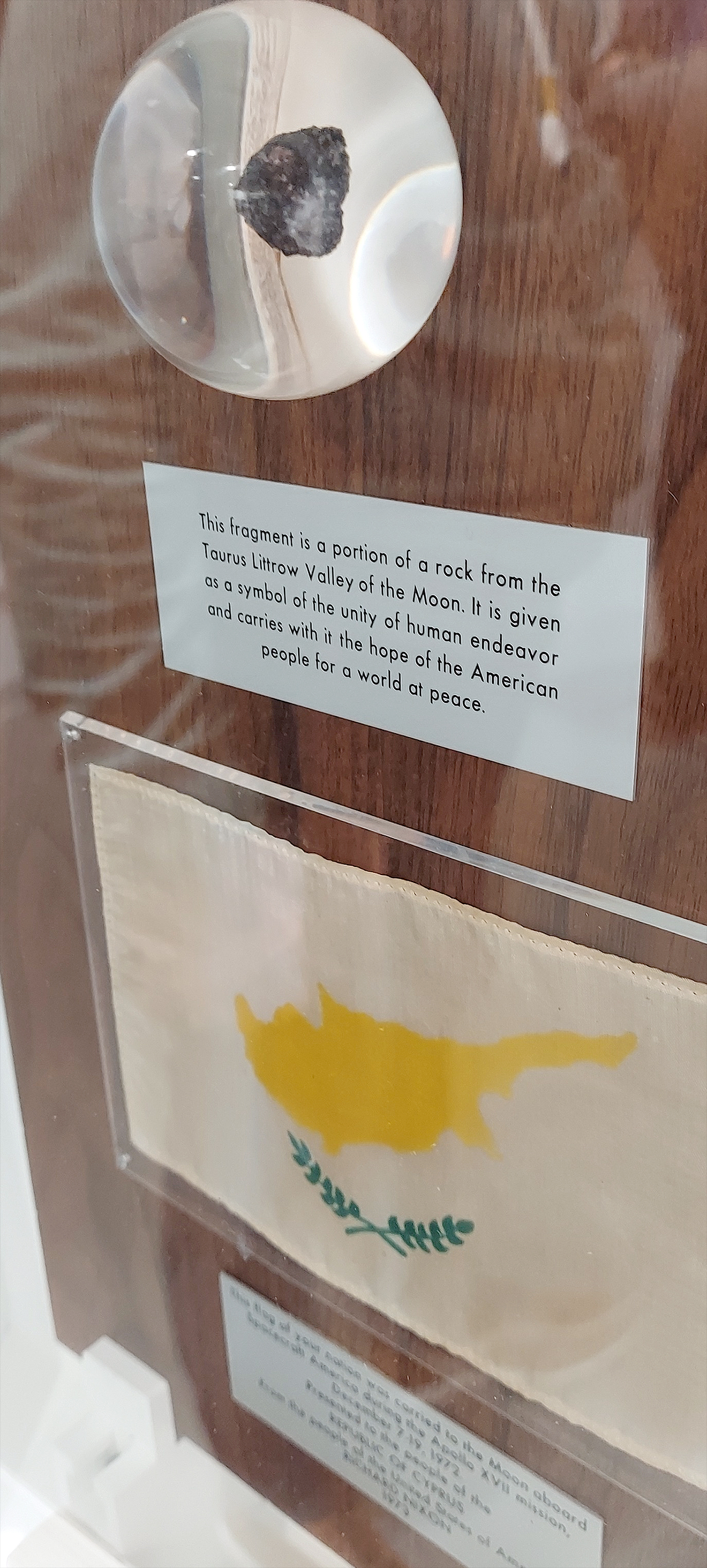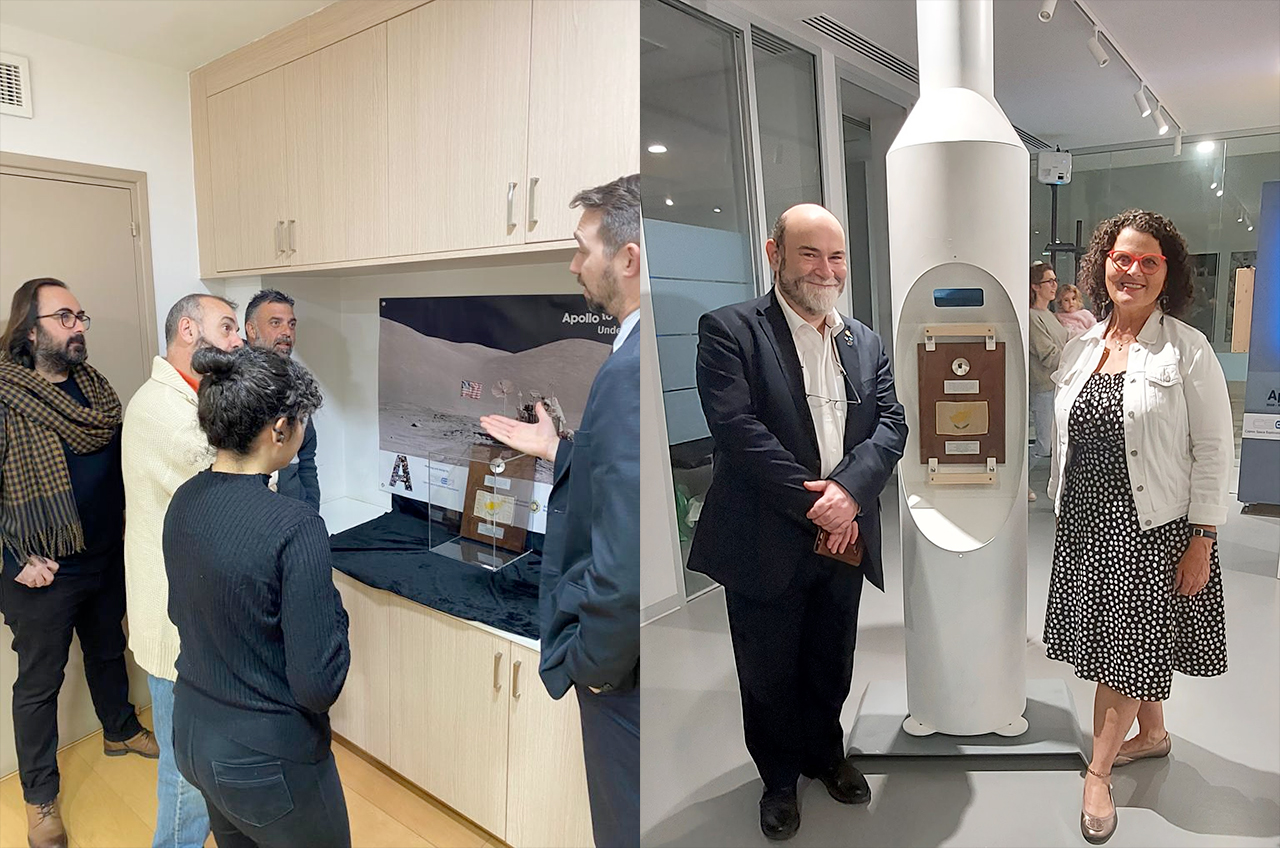50 years late, US gifts Apollo 17 moon rock to people of Cyprus
The handover is in time for the 50th anniversary of the Apollo 17 mission.

It took 50 years, but a moon rock intended as a goodwill gift from the United States to the people of Cyprus is finally being presented to the east Mediterranean island nation.
The lunar sample, encased in an acrylic ball and mounted to a wooden plaque, will be officially handed over during a ceremony at the presidential palace in Nicosia on Friday (Dec. 16). To celebrate the occasion, the U.S. Embassy arranged for the moon rock to be displayed by the Cyprus Space Exploration Organization (CSEO) as part of an exhibit open through Sunday (Dec. 18).
"We feel [it] is perfect timing because it's 50 years after it was brought to Earth," said George Danos, CSEO president, in an interview with the Associated Press.
Related: Where are the Apollo moon samples now?
On Dec. 13, 1972, as their third and last moonwalk was coming to its end, Apollo 17 astronauts Gene Cernan and Harrison Schmitt paused in front of the TV camera to dedicate a 6.5-pound (3 kilograms) moon rock as a goodwill gift to the world. Upon its return to Earth, the rock was divided into 200 or so pieces, each weighing 0.04 ounces (1.142 grams), to be presented to 135 countries, the 50 U.S. states and the U.S. territories.
It was the second and last time that the U.S. gave away Apollo-recovered lunar material. Each of the Apollo 17 goodwill moon rocks was presented on a plaque with a flag of the recipient nation or state that was flown on the mission. A plate included with the display read, in part, that the lunar sample was "given as a symbol of the unity of the human endeavor and carries the hope of the American people for a world of peace."

Unfortunately, the situation in Cyprus at the time was anything but peaceful. The president of the country, who the embassy planned to present the moon rock to in 1973, was ousted in a coup. A year later, the U.S. ambassador was assassinated and the embassy was evacuated.
Breaking space news, the latest updates on rocket launches, skywatching events and more!
"We do not think we should continue to try to thrust upon Cypriots something which they are not interested in receiving," the embassy's staff wrote in a telegram to the U.S. State Department in April of 1974. "In [the] tortured politics of this little island, [the] government could well prefer not to be associated with the fact that it was a Cypriot flag which Apollo 17 delivered to the moon."
That might have been the end of it, had the diplomat entrusted with the plaque turned it back in to the State Department or NASA. Instead, for reasons that are still not clear, he held onto it for the rest of his life. In 1996, his son found the moon rock among his the possessions of his late father in a storage locker in Virginia.

After realizing what it was he had, the son reached out to a space memorabilia dealer for help in trying to sell the moon rock. That inquiry led to the NASA Office of Inspector General (OIG) — the independent investigation arm of the space agency — being alerted, but it still took a few more years and a media campaign for the OIG to take action and then even more time for the son to agree to turn it over in return for immunity from prosecution.
Even then, it was still another decade before the State Department delivered the moon rock to Cyprus for its long-delayed presentation.
Disclosure: collectSPACE.com and one of its contributing writers, Joseph Gutheinz, a University of Arizona instructor and a former OIG investigator, were involved in finding and reporting the moon rock to NASA and urging for its delivery to Cyprus.
Follow collectSPACE.com on Facebook and on Twitter at @collectSPACE. Copyright 2022 collectSPACE.com. All rights reserved.
Join our Space Forums to keep talking space on the latest missions, night sky and more! And if you have a news tip, correction or comment, let us know at: community@space.com.

Robert Pearlman is a space historian, journalist and the founder and editor of collectSPACE.com, a daily news publication and community devoted to space history with a particular focus on how and where space exploration intersects with pop culture. Pearlman is also a contributing writer for Space.com and co-author of "Space Stations: The Art, Science, and Reality of Working in Space” published by Smithsonian Books in 2018.
In 2009, he was inducted into the U.S. Space Camp Hall of Fame in Huntsville, Alabama. In 2021, he was honored by the American Astronautical Society with the Ordway Award for Sustained Excellence in Spaceflight History. In 2023, the National Space Club Florida Committee recognized Pearlman with the Kolcum News and Communications Award for excellence in telling the space story along the Space Coast and throughout the world.

